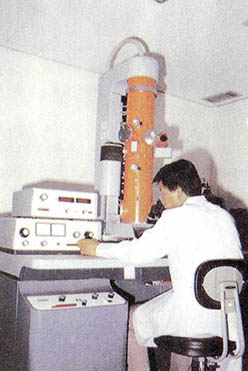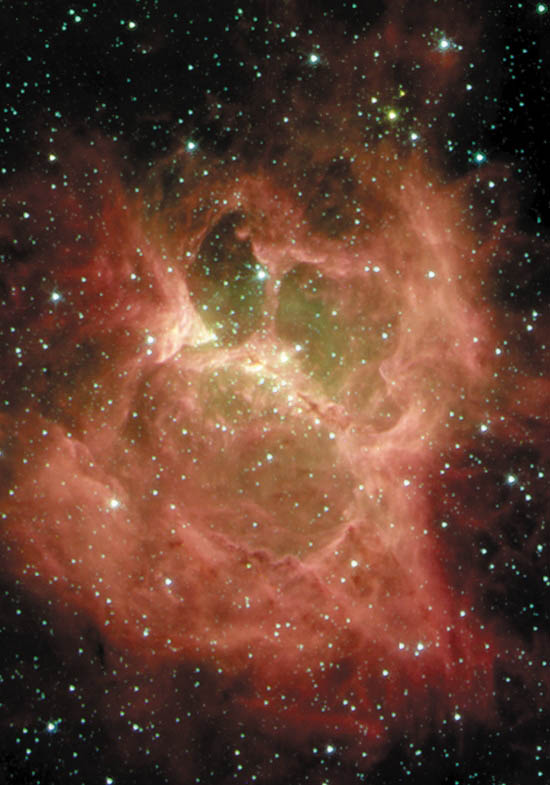동물성인가, 식물성인가, 혹은 광물성인가? 어쩌면 이런 당연한 분류법이 이젠 재고(再考)되어야 하는 때인지도 모른다. 1990년 여름, 일리노이 주립대학의 칼 워스씨가 모든 생명체를 그룹(群)과 소그룹(小群)으로 나누는 새로운 방안을 발표했기 때문이다. 이는 모든 생명체에 예외없이 존재하는 "리보솜"이라 불리는 작은 알맹이속의 리보핵산분자(소위 RNA)의 구조에 근거한 것이다.
모든 세포속의 핵산에 관한 현재의 청사진들에 의하면 리보솜은 단백질이 생산되는 곳이며 단백질없이 생명의 존재는 불가능하다.
리보솜은 가장 초기 세포들내에서 형성되었음이 분명하고 이를 이루는 RNA 분자들은 수십억년동안 약간의 변화만 초래했을 뿐 그 원형을 유지해 왔다.
그러나 약간이나마 변화가 있었다는 것이 중요하다. RNA 분자들은 예를 들어, "뉴클레오티드"라는 더 작은 분자들의 사슬식연결로 만들어진다. 리보솜내의 각 RNA분자들은 어느 특정부분에서는 머리핀 같은 곡선을 이룬다. 바로 이 곡선부분에 여섯 혹은 일곱개의 뉴클레오티드가 있다. 여섯개의 뉴클레오티드를 가진 세포들은 생명체의 한 그룹에 속한다. 또한 일곱개의 뉴클레오티드를 가진 세포들은 다시 조그마한 차이로 두개의 다른 그룹으로 나뉘어진다. 그래서 총 세 개의 그룹이 된다.
과거의 생명체들은 외형에 따라 주로 분류되어 왔다. 우리는 "스무고개놀이"에서 모든 문제들을 "동물성, 식물성, 혹은 광물성"으로 분류할때 모든 생명체가 동물이거나 식물이라고 생각한다. 또한 우리가 동물성이나 식물성으로 지적하는 미생물들도 있다. 아메바는 동물성이고 박테리아는 식물성이라고 생각해 온 것이다.
우리는 세포들에 대해 보다 자세히 연구함에 따라 궁극적으로 세포엔 두 가지 유형이 있음을 발견해 왔다. 원시적인 세포에는 핵산분자들이 세포전역에 퍼져있다. 원시세포란 박테리아를 포함하는 "원핵세포"로서(태양에너지의 공급으로 살아갈 수 있도록 하는) 클로로필을 지닌 것도 있고 그렇지 않은 것도 있다. 보다 복잡하고 진보된 유형의 세포들내에서 핵산은 "핵"이라고 하는 세포의 작고 한정된 지역에만 존재한다. 이들을 "진핵세포"라고 한다. 식물이나 동물은 진핵세포로 구성되어 있는데 식물의 세포에는 클로로필이 있고 동물의 세포엔 클로로필이 없다. 인간 역시 진핵세포로 만들어졌으며 물론 클로로필은 가지고 있지 않다.
그러나 워스씨처럼 우리가 리보솜내에 있는 RNA의 분자구조를 고려해보면 이 모든 논리는 전복되어버린다. 세 개의 대그룹 중에서 둘은 기본적으로 원핵세포들로서 단세포형이다.(원핵세포들은 둘 이상의 세포로 구성된 유기체들을 전혀 발전시키지 않았다). 이 중 하나는 박테리아라는 원핵세포이고 또 하나는 워스씨가 "아캐아"라고 부르는 원핵세포들인데 이들은 박테리아와 외형상으로는 매우 유사해 보이지만 진핵세포내의 RNA 분자에서 발견되는 속성을 지닌다.
결국 아캐아는 진핵세포의 성질을 발전시켜왔으며 이들로부터 워스씨가 "유카리아"라고 부르는 생명체의 세번째 그룹이 등장한 것으로 보인다. 이들은 핵을 포함한 세포들로 구성되어 있다.
유카리아는 다세포 방향으로 발전되는 유일한 생물체의 형태이다. 어떤 유카리아는 수 조(兆) 혹은 수백 조의 진핵세포로 구성된 유기체로 발전되어 왔다.(우리 인간이 바로 그 예다). 그러나 모두가 그렇지는 않다. 유카리아의 여섯 유형 중 셋은 철저하게 단세포들이다.
나머지 셋 중에서 둘은 식물성이다. 하나는 클로로필이 없는 "진균류"다. 대부분은 단세포이지만 버섯같은 다세포들도 있다. 또 하나는 클로로필이 있는 우리가 잘 아는 녹색식물이다. 이들 역시 조류(藻類)처럼 단세포인 경우도 있고 세쿼이어 나무처럼 엄청나게 큰 것들도 있다.
마지막으로 유카리아의 마지막 유형은 동물이다. 이들은 우리 인간의 시각에서 가장 진보된 것이며 무게가 1백50t이나 되는 큰 고래도 포함된다.(어떤 나무들은 더 무거울 수도 있겠으나 그 무게는 나무를 지탱시키는 역할뿐 실제 살아있지는 않은 대부분 죽은 조직체때문이다. 그러나 동물의 몸은 거의 살아 숨쉬는 조직체로 구성되어 있다).
이 마지막 유형은 우리 인류의 위치를 어느정도 설명해준다.
약 35억년전 생명이 시작된 이래 생명체들은 20억년 이상 단세포 원핵세포 형태를 유지하였다. 약 14억년 전에 이르러서야 세번째 그룹인 유카리아가 나타났고 이들 역시 다음 6억년 가까이를 단세포형태로 머물러 있었다.
약 8억년전에 다세포인 진핵세포들이 나타나기에 이르렀는데 처음엔 여러종류의 기생충에 불과했었다. 6억년전에 바다의 껍질있는 조개류가 등장하였고 5억년 전에 이르러서야 우리 인간에 속하는 동물체들이 나타났다.
인류뿐만이 아니라 가장 원시적인 물고기부터 우리와 관계깊다는 동물들까지도 지구위에선 지각생들이라는 것이다.
Animal' vegetable or mineral? It may be time to rethink these "given" categories. Carl Woese, a biologist at the University of Illinois, announced in summer 1990 a new way of dividing all living things into groups and subgroups. The division is based on the structure of ribonucleic acid molecules(RNA) in tiny granules called "ribosomes" that are present in all living things without exception.
The ribosomes are the sites on which proteins are manufactured according to the nucleic acid blueprints present in all cells, and life cannot exist without proteins. The ribosomes must have been formed in the very earliest cells and the RNA molecules making them up have maintained themselves with only minor changes for billions of years.
Some minor changes have, however, taken place. The RNA molecules are, for instance, made up of chains of smaller molecules called "nucleotides." Every RNA molecule in the ribosomes has a hairpin curve at a certain place. In that curve there are either six or seven nucleotides. Every cell with six nucleotides belongs to one grand group of life forms. Other small differences divide the seven-nucleotide cells into two other grand groups, making three altogether.
Historically, life forms were divided by appearance. When we play "20 questions"we still divide all objects into "animal, vegetable, or mineral"─We consider all living things to be either animals and plants. There are microscopic life forms, too, which we used to assign to animals and plants─amoebas were considered animals and bacteria were considered plants. Eventually, as we studied cells more closely, we found that there were two major kinds of cells. In the more primitive cells, the nucleic acid molecules were spread throughout the cell. These made up the "prokaryotes" and included bacteria, some with chlorophyll(which allows them to live on the energy of sunlight) and some without. In more complex and advanced type of cells, nucleic acids are localized in a small region within the cell called the "nucleus." These are "eukaryotes." Plants and animals are made up of cells that are eukaryotes─plants having cells with chlorophyll, animals without chlorophyll. Human beings are made up of cells that are eukaryotes and that, of course, contain no chlorophyll.
All this is overthrown, however, if, as Woese does, we consider the molecular structure of the RNA in ribosomes. It seems that of the three grand divisions, two are single-celled life forms with the cells prokaryote in nature.(Prokaryote cells have never developed organisms that are made up of more than one cell). One grand division of prokaryotes are the "bacteria." A second grand division of prokaryotes Woese calls the "Archaea" resembles bacteria very strongly in appearance but have certain characteristics in their RNA molecules more like the eukaryotes. Apparently the Archaea developed eukaryotic characteristics and from them the third grand division of life, which Woese calls "Eucarya," evolved. These are made up of cells containing nuclei.
The Eucarya are the only life forms that ever developed in the multicellular direction. Some Eucarya developed into organisms made up of trillions or even hundreds of trillions of eukaryotic cells(We are ourselves examples of this). But not all─of the six main divisions of the Eucarya, three are exclusively one-celled in nature.
Of the remaining three, two are plantlike in nature. One, without chlorophyll, make up the "fungi." Most are one-celled but there are multi-celled forms like mushrooms. The second contain chlorophyll and are the familiar green plants. Again, some of these are single-celled, like algae, but there are gigantic forms like Sequoia trees.
Finally, the last group of the Eucarya are animals, These are, from our own standpoint, the most advanced of all, and include giant whales that may weigh up to 150 tons.(Some plants are heavier still but most of a tree is supporting woody tissue that is not truly alive, whereas animals consist almost entirely of living tissue.)
In a way, this puts us in our place. After life began, about 3.5 billion years ago, life forms remained single-celled and prokaryotic for over two billion years. Only about 1.4 billion years ago, the third grand division, Eucarya, developed and for the next 600 million years, they too remained single-celled life forms.
Only about 800 million years ago, the first multicellular eukaryotes began to develop, and at first only as different kinds of worms. Only 600 million years ago life forms as advanced as shelled sea-life developed, and only 500 million years ago the group of animals to which we belong developed.
Not only we, but all the animals we are related to, down to the most primitive fish, are Johnny-come-latelies on Earth.
(c) 1990, Los Angeles Times Syndicate
이 기사의 내용이 궁금하신가요?
기사 전문을 보시려면500(500원)이 필요합니다.
1990년 12월 과학동아 정보
🎓️ 진로 추천
- 생명과학·생명공학
- 화학·화학공학
- 환경학·환경공학

















